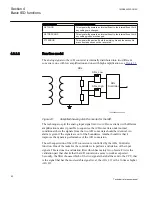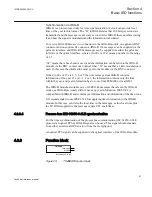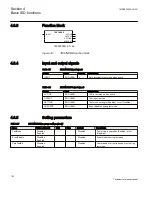
Rate accuracy
In the IED, the rate accuracy at cold start is 100 ppm but if the IED is synchronized for
a while, the rate accuracy is approximately 1 ppm if the surrounding temperature is
constant. Normally, it takes 20 minutes to reach full accuracy.
Time-out on synchronization sources
All synchronization interfaces has a time-out and a configured interface must receive
time-messages regularly in order not to give an error signal (TSYNCERR). Normally,
the time-out is set so that one message can be lost without getting a TSYNCERR, but if
more than one message is lost, a TSYNCERR is given.
4.3.2.3
Synchronization alternatives
Three main alternatives of external time synchronization are available. The
synchronization message is applied:
•
via any of the communication ports of the IED as a telegram message including
date and time
•
as a minute pulse connected to a binary input
•
via GPS
The minute pulse is used to fine tune already existing time in the IEDs.
Synchronization via SNTP
SNTP provides a ping-pong method of synchronization. A message is sent from an
IED to an SNTP server, and the SNTP server returns the message after filling in a
reception time and a transmission time. SNTP operates via the normal Ethernet
network that connects IEDs together in an IEC 61850 network. For SNTP to operate
properly, there must be an SNTP server present, preferably in the same station. The
SNTP synchronization provides an accuracy that gives +/- 1 ms accuracy for binary
inputs. The IED itself can be set as an SNTP-time server.
SNTP server requirements
The SNTP server to be used is connected to the local network, that is not more than 4-5
switches or routers away from the IED. The SNTP server is dedicated for its task, or at
least equipped with a real-time operating system, that is not a PC with SNTP server
software. The SNTP server should be stable, that is, either synchronized from a stable
source like GPS, or local without synchronization. Using a local SNTP server without
synchronization as primary or secondary server in a redundant configuration is not
recommended.
Synchronization via Serial Communication Module (SLM)
On the serial buses (both LON and SPA) two types of synchronization messages are sent.
Section 4
1MRK505222-UUS C
Basic IED functions
88
Technical reference manual
Summary of Contents for Relion 670 series
Page 1: ...Relion 670 series Line differential protection RED670 ANSI Technical reference manual...
Page 2: ......
Page 40: ...34...
Page 50: ...44...
Page 60: ...54...
Page 126: ...120...
Page 384: ...378...
Page 496: ...490...
Page 556: ...550...
Page 602: ...596...
Page 620: ...614...
Page 794: ...788...
Page 864: ...858...
Page 988: ...982...
Page 998: ...992...
Page 1084: ...1078...
Page 1164: ...1158...
Page 1168: ...1162...
Page 1220: ...1214...
Page 1230: ...1224...
Page 1231: ...1225...
















































